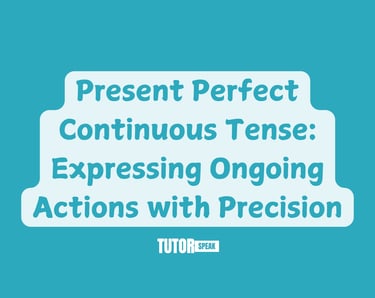Present Perfect Continuous Tense: Expressing Ongoing Actions with Precision
Learn how to use the present perfect continuous tense in English with examples, rules, and key differences from the present perfect. Visit TutorSpeak to master all English tenses.
TutorSpeak
2 min read


📝 Present Perfect Continuous Tense: Expressing Ongoing Actions with Precision
Learn how to use the present perfect continuous tense in English with examples, rules, and key differences from the present perfect. Visit TutorSpeak to master all English tenses.
1. What Is the Present Perfect Continuous Tense?
The present perfect continuous tense (also called the present perfect progressive tense) describes actions that started in the past and are still continuing or have recently stopped but have present results.
Examples:
I have been studying English for two hours.
She has been working here since 2018.
They have been waiting for the bus since morning.
It focuses on the duration or continuity of an action, not just the result.
2. How to Form the Present Perfect Continuous Tense
The structure is:
Subject + has/have + been + verb + -ing
Examples:
I have been reading a new book.
He has been learning French.
We have been playing football all day.
⚠️ Tip:
Use has for he, she, it and have for I, you, we, they.
3. When to Use the Present Perfect Continuous Tense
Use this tense to describe:
An action that began in the past and continues now:
→ She has been studying since 8 a.m.An action that has recently stopped but has results now:
→ I’m tired because I have been running.A temporary activity:
→ We have been staying with our grandparents this week.To emphasize duration:
→ He has been working on this project for months.
For detailed examples of present perfect and other tenses, visit TutorSpeak’s Master English Tenses Guide.
4. Present Perfect vs Present Perfect Continuous
Although both connect the past and the present, they express different focuses:
Present Perfect Tense → Focuses on result
Example: I have written three emails today.
Present Perfect Continuous Tense → Focuses on duration or ongoing action
Example: I have been writing emails all morning.
5. Common Mistakes to Avoid
❌ She has been learn English since 2020.
✅ She has been learning English since 2020.
❌ I have been know him for years.
✅ I have known him for years.
(State verbs like know, like, believe are not used in continuous forms.)
6. Quick Practice Examples
Complete the sentences:
I ___ (study) for three hours.
They ___ (wait) since 10 a.m.
He ___ (not/sleep) well lately.
We ___ (work) on the website all day.
Answers: have been studying – have been waiting – has not been sleeping – have been working
7. Summary
The present perfect continuous tense helps express actions that began in the past and continue in the present, or actions with visible present effects. It’s ideal for highlighting duration, repetition, and ongoing effort.
To continue learning all English tenses with examples and explanations, visit TutorSpeak.



